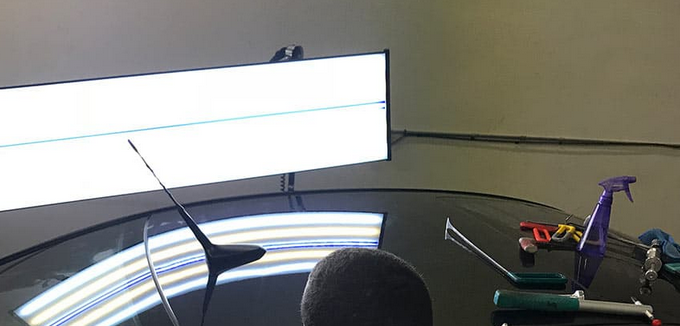
What is PDR? It is short for Paintless Dent Repair and is a dent removal process that does not harm the factory paint. It is most widely used for car hail damage but is also used to fix dents and dings in general. The biggest benefit of PDR over other methods is that the vehicle remains 100% original, including the paint.
Now that you know what PDR is, here is a list of 9 common FAQ’s to help you decide if it is right for you.
What is PDR?
How does PDR work?
Is PDR safe?
How long does PDR take?
How much does PDR cost?
Will the dents return?
What can’t be fixed with PDR?
Is PDR covered under my insurance?
Is PDR Eco friendly?
1. What is PDR?
PDR is short for Paintless Dent Repair. It is a method of dent removal that does not harm the factory paint during the process, as we mentioned earlier. It is believed to have been invented around the 1960’s as an alternative to traditional body shop methods that require panel replacement, body fillers, and re-painting of the damaged area.
2. How does PDR work?
A PDR technician uses specialized tools to gently maneuver a dent back to its original position. Modern vehicles have access spaces behind the body panels that the technician can use to reach most dents. This requires skill and precision from the technician. Sometimes, interior panels will be removed to reach certain dents, such as a door ding. PDR tools are specifically designed to reach difficult places and are heavy-duty enough to move metal. From there, the dent is slowly pushed out. Special lights let the technician know when the dent is perfectly positioned. When the dent cannot be pushed out, it has to be pulled or lifted out. For these types of dents, a PDR glue gun is used to pull it out. If it does not line up exactly as intended, the technician will continue maneuvering it with hand tools until it does.
3. Is PDR safe?
PDR is the safest way to fix a dent in almost all cases since it is non-invasive unlike the other methods of repair. A body shop may have to use fillers and aftermarket body panels to fix a dent before painting the affected area. With PDR, your factory paint is not harmed and the vehicle stays 100% original. PDR retains the full value of the vehicle as it looks as good as it did before the damage took place. This is the reason car dealerships use PDR on their vehicles for anything from a minor dent to hail damage.
4. How long does PDR take?
PDR can take anywhere from an hour for a small dent or ding to several days for a full auto hail repair. Each dent is individually removed so the time it takes to repair one depends on 2 primary factors:
Size:
For smaller dents and door dings, it can take an hour or two for the repair. Our Express Service can repair most dents in a day and sometimes while you wait. Larger dents take longer because there is more metal to push out. If the dent is large and damages a body line, it can take several hours. Collision PDR can take a day or two. For car hail damage, it can take several days to a week to repair. It all depends on the extent of the damage.
Location:
The location of the dent has a lot to do with how long PDR will take to fix it. If the dent is easy to access from behind, the metal then it may take an hour or so. This is most common in hood dents and shopping cart dings. If the dent is on the roof of the vehicle or the door, it takes longer. In those situations, the removal of interior parts may be necessary for the technician to reach the dent.
In either case, PDR is the fastest way to fix a dent. It doesn’t require filling, sanding, or paint as other methods require. The technician can start working on the vehicle immediately.
5. How much does PDR cost?
WOYO PDR007:397USD https://www.obd2tool.com/goods-10078-WOYO-PDR007-Auto-Body-Repair-PDR-Tools.html
WOYO PDR009:579USD https://www.obd2tool.com/goods-10200-WOYO-PDR009-Auto-Body-Repair-Tool.html
6. Will the dents return?
No. Once PDR is performed, the dents will not return or “Pop out” again. It is a permanent dent fix. A dent causes the metal to stretch and causes it to stress. Leaving it in this state can cause further damage to the metal and paint. When a dent is repaired with PDR, the metal is gently maneuvered back into place. This alleviates the stress and flattens the metal back to its original state. Since the metal is returned to the original condition, there is nothing to pop back out.
7. What can’t be fixed with PDR
PDR is the best way to fix dents but it does have some limitations. The biggest limitation is if the paint is chipped, cracked, or otherwise damaged in any way then it can not be repaired by PDR. Another scenario would be a deep crease or the metal is so badly damaged that it make more sense to replace the panel. All in all, most are pleasantly surprised about what PDR can fix.
8. Is PDR covered under my insurance?
Yes! PDR is covered with full-coverage insurance. In many cases, there is no reason to involve them as small dent removal typically costs less than a deductible.
9. Is PDR Eco Friendly?
Yes! PDR is much more Eco friendly compared to other methods of dent repair. Since paint is not required, there are no fumes or harsh chemicals used. Other than the electricity in the building to run the lights and maybe a radio, there is little energy required with PDR. It is about as Eco friendly as you can get.
Leave a Reply